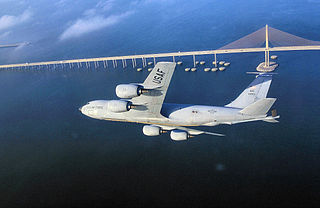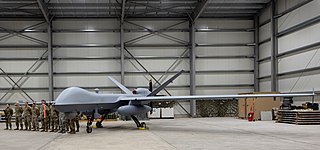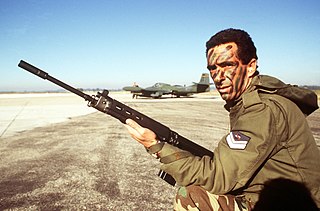
The 91st Missile Wing is a United States Air Force unit assigned to the Air Force Global Strike Command Twentieth Air Force. It is stationed at Minot Air Force Base, North Dakota as a tenant unit.

The 414th Expeditionary Reconnaissance Squadron is a provisional United States Air Force unit. It operates the General Atomics MQ-1 Predator, last known assigned to the 39th Expeditionary Operations Group, Incirlik Air Base, Turkey. The 39th Expeditionary Operations Group was part of the 39th Air Expeditionary Wing. It controls the launch and landing of the Predator air vehicles.

The 91st Bomb Group (Heavy) was an air combat unit of the United States Army Air Forces during the Second World War. Classified as a heavy bombardment group, the 91st operated B-17 Flying Fortress aircraft and was known unofficially as "The Ragged Irregulars" or as "Wray's Ragged Irregulars", after the commander who took the group to England. During its service in World War II the unit consisted of the 322nd, 323rd, 324th, and 401st Bomb Squadrons. The 91st Bomb Group is most noted as the unit in which the bomber Memphis Belle flew, and for having suffered the greatest number of losses of any heavy bomb group in World War II.

The 407th Air Expeditionary Group was a provisional United States Air Force unit assigned to the United States Air Forces Central Command, 332d Air Expeditionary Wing. It was stationed at Ali Air Base, Iraq, until the closure of the base on 16 December 2011. It was activated as part of the 332d Air Expeditionary Wing due to Military intervention against ISIL at Ali Al Salem Air Base, Kuwait, and Ahmad al-Jaber Air Base, Kuwait. In 2023 Jane's Defence Weekly confirmed a June 2022 AFCENT statement that the 407 AEG had been inactivated.

The 455th Air Expeditionary Wing was a provisional United States Air Force unit located at Bagram Airfield, Afghanistan, from 2002 to 2021. It was one of two expeditionary wings in Afghanistan. Most wing personnel were located at the Air Force Village known as Camp Cunningham.

The 451st Air Expeditionary Group was a provisional United States Air Force USAFCENT unit. It was assigned to Kandahar Airfield and is also the host unit at Kandahar. It reported to the 455th Air Expeditionary Wing at Bagram Air Base.

The 409th Air Expeditionary Group is a provisional United States Air Force unit assigned to United States Air Forces Europe (USAFE), which may activate or inactivate the group as needed at any time.

The 6th Attack Squadron is an active United States Air Force unit, assigned to the 49th Wing at Holloman Air Force Base, New Mexico. The squadron is a formal training unit for crews learning to operate unmanned aerial vehicles.

The 91st Air Refueling Squadron is part of the 6th Air Mobility Wing at MacDill Air Force Base, Florida. It operates the Boeing KC-135R Stratotanker aircraft conducting air refueling missions.

The 909th Air Refueling Squadron is part of the 18th Wing at Kadena Air Base, Japan. It operates the KC-135 Stratotanker aircraft conducting air refueling missions.

The 91st Attack Squadron is a United States Air Force Reserve unit. Its last assignment was with the 81st Tactical Fighter Wing, stationed at RAF Woodbridge, England. It was inactivated on 14 August 1992. The squadron was redesignated the 91st Attack Squadron and activated on 5 April 2013 at Creech Air Force Base, Nevada, where it is an associate of the 432d Wing.

The 28th Operations Group is the flying component of the United States Air Force 28th Bomb Wing, stationed at Ellsworth Air Force Base, South Dakota.

The 91st Operations Group is the operational component of the 91st Missile Wing, assigned to the Air Force Global Strike Command Twentieth Air Force. It is stationed at Minot Air Force Base, North Dakota.

The 98th Air Refueling Squadron is an inactive United States Air Force unit. Its last assignment was with the 92d Operations Group at Fairchild Air Force Base, Washington, where it was inactivated on 1 July 1998.

The 322d Expeditionary Reconnaissance Squadron is a provisional unit of the United States Air Force, assigned to Air Combat Command to activate or inactivate as needed.

The 701st Tactical Air Support Squadron is an inactive United States Air Force unit. It was last assigned to the 601st Tactical Air Control Wing at Bergstrom Air Force Base, Texas, where flew helicopters to support Tactical Air Control System units from 1967 until it was inactivated on 31 January 1980.

The 323d Strategic Reconnaissance Squadron is an inactive United States Air Force unit. Its last was assigned to the 91st Strategic Reconnaissance Wing, stationed at Lockbourne Air Force Base, Ohio. It was inactivated on 8 November 1957.

The 904th Expeditionary Air Refueling Squadron is an inactive United States Air Force unit. It was last assigned to the 320th Bombardment Wing at Mather Air Force Base, California, where it was inactivated on 30 September 1986.

The 731st Expeditionary Attack Squadron is a provisional unit of the United States Air Force. It was activated circa 4 March 2021 at the Romanian Air Force 71st Air Base in Câmpia Turzii. The unit is part of the 31st Expeditionary Operations Group and operates General Atomics MQ-9 Reaper unmanned aerial vehicles.

The 24th Tactical Air Support Squadron was a ground attack squadron of the United States Air Force. It was last active at Nellis Air Force Base in Nevada, prior to being inactivated during December 2020.






























